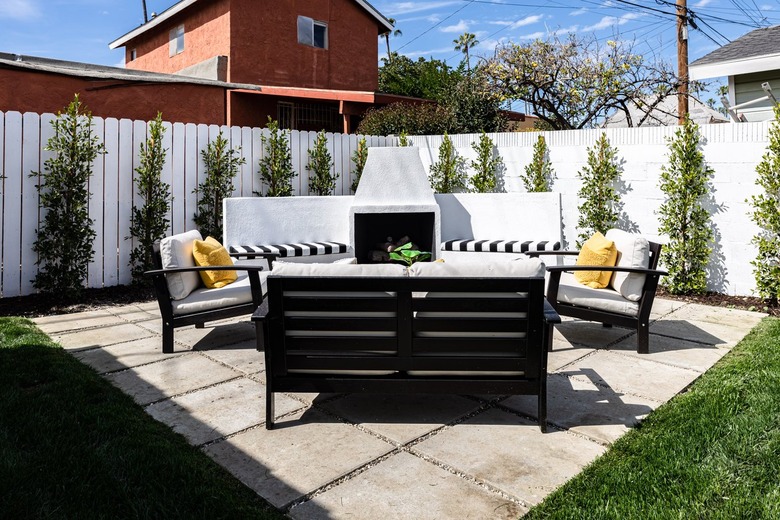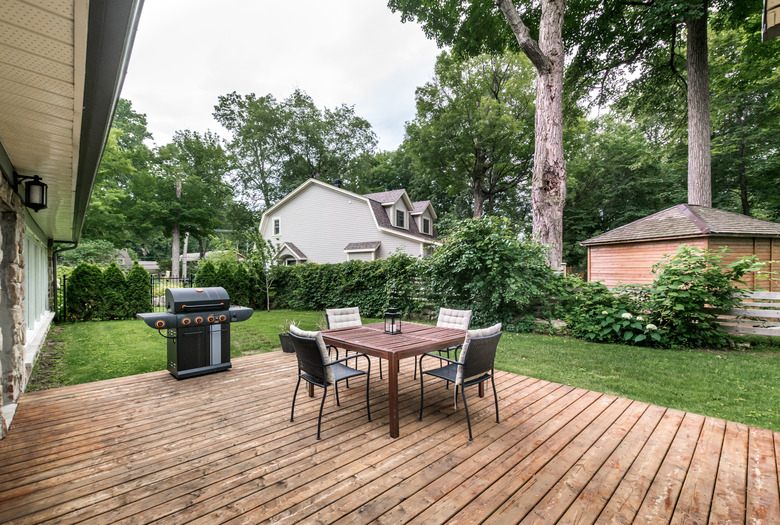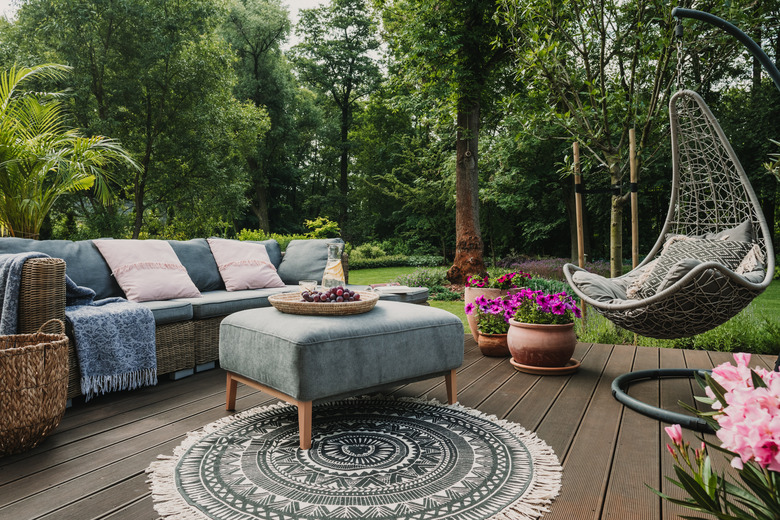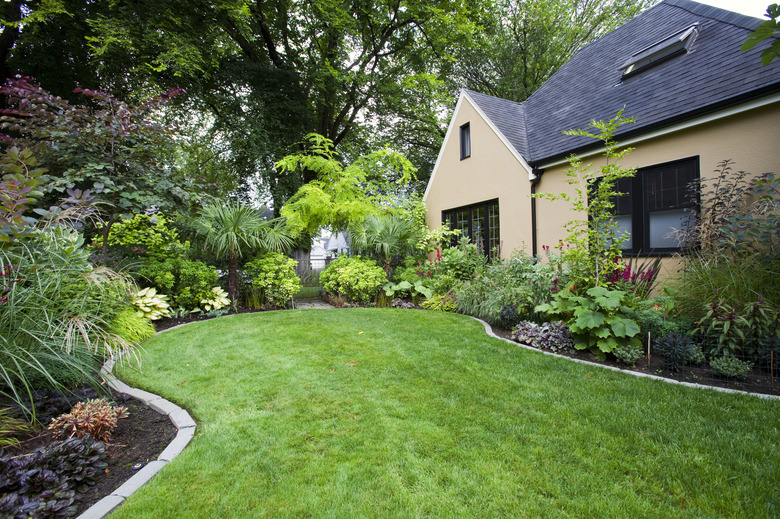Backyard Landscaping Tips
We may receive a commission on purchases made from links.
Although you may choose a landscape design for your front yard with the goal of curb appeal in mind, you may approach your backyard landscaping goal from an entirely different perspective. The neighbors and passersby will enjoy the beauty of your front yard, but you'll relish the backyard landscape as your own private retreat.
Whether you want to transform the look of your backyard with a complete makeover or simply tweak the current design with a few DIY changes, you don't have to be a professional landscape designer to tackle the project. Just follow some time-tested landscape design principles and tips, and you can make it happen.
6 Principles of Landscape Design
6 Principles of Landscape Design
A basic understanding of the six principles of landscape design will help you apply these standards to your backyard landscaping design. You don't have to worry that following these principles must be done at the expense of abandoning your personal taste or artistic expression. They're simply touchstones that can help keep you on track as you implement the plan for your backyard landscaping ideas.
Instead of relying on a flight of landscaping ideas that lack a cohesive design plan for the backyard, consider these six principles of landscape design to help you form a plan:
- Simplicity. You can pack a punch even in a small
landscape and still achieve simplicity of design. Simplicity in garden design
doesn't mean a bare-bones approach to landscaping, which leaves you with only a
few plants to enjoy. Achieving simplicity is the result of working around a
common theme and, as the University of Florida IFAS Extension notes, using a theme that has identifiable characteristics and a recognizable style. - Focalization. In landscape architecture, a
design's emphasis is called the focal point, which fulfills the design
principle known as focalization. In a backyard garden, the focal point may be a
shaded sitting area with an inviting gazebo. - Balance. Michigan State University Extension describes
balance in landscape design as the quality that provides a visually pleasing
experience as well as a comfortable sense of well-being. Balance assigns equal
visual weight on either side of a central axis in the landscape, whether the balance
is achieved by symmetry, asymmetry or proximity. Symmetrical balance is what
you'll choose if you prefer the look of a formal garden, in which each side of
a landscape's center line is a mirror image of the other. Asymmetrical balance
offers a more informal design look without the mirror image reflection but
with equal visual weight on either side of the center line. Proximal/distal
balance doesn't rely on the side-to-side relationship in symmetrical and
asymmetrical designs but on the near/far relationship of objects in the
foreground, midground and background. - Proportion/scale. Two types of proportion influence scale in
the landscape. Relative proportion compares one object to another object, and
absolute proportion considers the size of a single object. Installing that
water feature you've been wanting won't violate the principle of proportion/scale
unless the one you have in mind is the size of the Trevi Fountain, and your home
isn't exactly the size of a castle. - Rhythm and line. Rhythm adds repetition, and line adds form and shape. For example, you've added a rhythmic flow when you repeat design elements throughout your landscape, such as the same plant or group of plants placed in different locations. Straight or curved lines—which you'll see both horizontally and vertically formed by trees, sidewalks, fences and your home—add to this flow. When you have too many lines, your landscape will look disjointed.
- Unity. When the individual design principles
cooperatively work as a single unit, they bring a harmonious aesthetic to the
landscape. As the North Carolina State Extension notes, the result is a
landscape that is visually pleasing when viewed from all angles.
Landscape Design Principles vs. Components
Landscape Design Principles vs. Components
Although many DIY landscapers may first think of plants when they consider landscape design principles, you won't see plants listed among the six principles because principles represent standards — not individual components, such as plants and other backyard enhancements. Landscape design components often support more than one principle. For example, plants fulfill multiple principles, such as focalization, balance and rhythm and line.
When choosing plants for your backyard landscape, expanding your choices from those that suit your personal preference to those that also fulfill design principles results in a landscaping win-win situation. If red is your favorite color, consider vibrant pops of this shade interspersed through other plant colors, which often makes a greater impact than a solid row of plants with red flowers.
If, for example, you place most of your plants along the back wall of your home as foundation plantings and leave the rest of your backyard mostly bare, the visual weight of the back wall plus the plants pulls the comprehensive backyard design severely out of balance.
Backyard Landscaping Design Themes
Backyard Landscaping Design Themes
Before you even choose plants for your backyard, deciding on a theme can help you organize your landscaping ideas. Your landscape design theme considers not only your personal style and preferences but also the site conditions in your backyard.
For example, do you have a sunny or shady backyard or areas of both in the same landscape? This helps rule out certain plants that rely on varying levels of light to prosper. The location of your landscape, based on U.S. Department of Agriculture plant hardiness zones, will also help you in the selection of plants that are suitable for the climate where you live.
Plants aside, your backyard landscaping theme is also informed by the overall look you want to achieve. If you prefer the design of a formal garden, which leans toward a symmetrical look with straight lines and manicured plants, note that the beauty of this landscape style requires more maintenance than informal designs. If you work full time and have little time to maintain this type of labor-intensive design, you may have to hire a gardening professional to keep your backyard looking its best.
You may decide on a backyard landscaping theme with a cultural or historical influence, such as an English, Japanese or Italian garden. You may be drawn toward the look of an informally structured cottage garden or the minimalist modern style, which features a small collection of similar plants or a landscape solely comprised of ornamental grasses, for example. If your theme is one that attracts hummingbirds and butterflies, you'll want to make sure that you choose plants that offer nectar as a food source as well as host plants for butterfly larvae to eat.
Designing for the Senses
Designing for the Senses
By including sensory experiences in your backyard ideas for landscaping, you'll be able to bump up your enjoyment of your private retreat, particularly as you sit outside early in the morning or late in the evening after a long day. For most people, sight is the primary consideration in a backyard design as they carefully choose plants, structures and garden accessories to enhance the landscape without having the distractions, such as traffic, that exist in a front yard landscape. However, catering to the other senses is often overlooked, leaving a backyard design lacking.
For a richer backyard landscape experience, consider a garden design that fulfills these senses:
- Sight. Color, texture, form and movement are just some of
the visual expressions of a landscape. Coordinate these elements by considering
plants as well as structures and other garden components. For example, even the
color or style of the back wall of your home can form a complementary backdrop for the landscape
in front of it. If your home's back wall is a different material than the front facade, use this difference to your backyard design's advantage by customizing the design. - Sound. You can enjoy your backyard landscape even with your
eyes closed. The singing of birds, the music of wind chimes or the soothing sound
of a water feature expands your garden enjoyment beyond the visual. - Fragrance. Scent is a subjective preference, so be sure to
choose plants in the fragrance spectrum that are pleasing to you. Otherwise,
even though you consider certain types of flowers beautiful to behold, you may not want
to plant them if their fragrance is unappealing, as your favorite backyard sitting area may not be so enjoyable. - Taste. Vegetable gardens, which typically are located in the backyard, allow you to enjoy (literally) the fruits of your labor. Even if you don't have a dedicated
vegetable garden, consider an edible landscaping design, which features a mixture of ornamental as well as edible plants in an aesthetic arrangement. - Touch. The softness of some types of flowers, the roughness
of some types of plant bark and the cool feel of water in an aquascape allow
you to interact with the components in your landscape instead of merely being a bystander.
Outdoor Living Spaces
Outdoor Living Spaces
If you think of your backyard landscape as an outdoor living space, you can more easily subdivide the landscape into separate "rooms." Even if you have a very small backyard, it can still function as a single room, in which you'd arrange plants and other design elements like you would arrange furniture in your home, as explained by the North Carolina Cooperative Extension.
If you have a large backyard, you can designate different functional areas that you generally don't find in the more highly visible front yard. For example, in the backyard, you can enjoy an outdoor kitchen or fire pit with a dining area, an outdoor den with a fireplace or chiminea, an outdoor seating area or decking that can serve as a reading room or an outdoor entertainment space for a swimming pool or playground. Add halls or corridors to an outdoor living space with the use of sidewalks or garden paths. If you want a covered doorway that connects one garden room to another, consider growing vines over a pergola.
Form in Landscape Design
Form in Landscape Design
The element of form is part of the architecture of your backyard landscape design. Some forms already exist, such as the natural contour of your landscape and the lines of your home, and other forms are ones you can establish, including plants and garden structures. Even open spaces contribute form since they take different shapes to define round or rectangular areas. Use the element of form in your landscape design to create a seamless integration of movement and flow throughout your backyard.
Plants have different forms, including upright, weeping, round and columnar, and plant forms may change depending on the season. For example, some deciduous trees have a triangular form during spring and summer because of their foliage. However, in fall, when the leaves drop from these deciduous trees, their filled-in triangular form gives way to an open outline of bare branches. Use deciduous trees to your advantage, as they provide shade during the summer and let in sunlight for warmth during the winter.
If you're counting on trees and shrubs to provide living green screens to help keep your backyard private, make sure you plant evergreens. Many deciduous shrubs and trees have full shapes in spring and summer, but they'll expose your private backyard to your neighbors when they drop their leaves in the fall.
Hardscapes in Landscape Design
Hardscapes in Landscape Design
Using hardscapes in your backyard design can define garden rooms, add form and texture to the landscape and complement softscapes (plants). Hardscapes can serve a functional purpose, such as retaining walls that mitigate erosion. Stepping stones with turf or a ground cover between them offer a blend of hardscape and softscape.
Although the primary hardscapes you generally see in your front yard are often utilitarian, such as your driveway and the sidewalk leading to your front door, you can get a little more artistic with your backyard hardscaping design. A flagstone patio that's tucked out of view from the street may be your favorite sitting area, or a deck installed outside your kitchen can hold a container herb garden.
If your backyard is visible from the street because, for example, you have a corner lot, a privacy fence will provide the walls to keep your backyard living space hidden from view. Even if you have a chain-link fence, you can plant vines to cover it and form a living green wall.
Plant Choices in Landscape Design
Plant Choices in Landscape Design
An important component of backyard landscape design is the selection, proper placement and proper spacing of plants. Whether you like the look of manicured flower beds or lower-maintenance raised beds, a landscape that's filled with greenery instead of vibrant colors or mulched islands with trees or shrubs, you'll want to consider the mature sizes of plants instead of the diminutive specimens often sold in nursery containers.
Certain plants can also add a safety feature to a backyard, which is often hidden from view of the street. Planting evergreen shrubs with prickly leaves underneath the windows on the back side of your house discourages prowlers while offering a textural backdrop for shorter landscape plants.
As you pull everything together for your backyard landscape design, a valuable resource is the cooperative extension service. Not only can your local extension office provide free advice and resources but it can also offer suggestions for plants that perform best in your location. The Old Farmer's Almanac has an online listing by state that can steer you in the right direction, or you can simply perform an online search to find the closest extension office.
References
- University of Florida IFAS Extension: Landscape Design – Finding Inspiration for a Design Theme
- Michigan State University Extension: Principles of Landscape Design
- North Carolina State Extension: Landscape Design
- University of Florida IFAS Extension: Basic Principles of Landscape Design
- North Carolina Cooperative Extension: Basic Steps for Home Landscaping
- The Old Farmer's Almanac: Cooperative Extension Services



